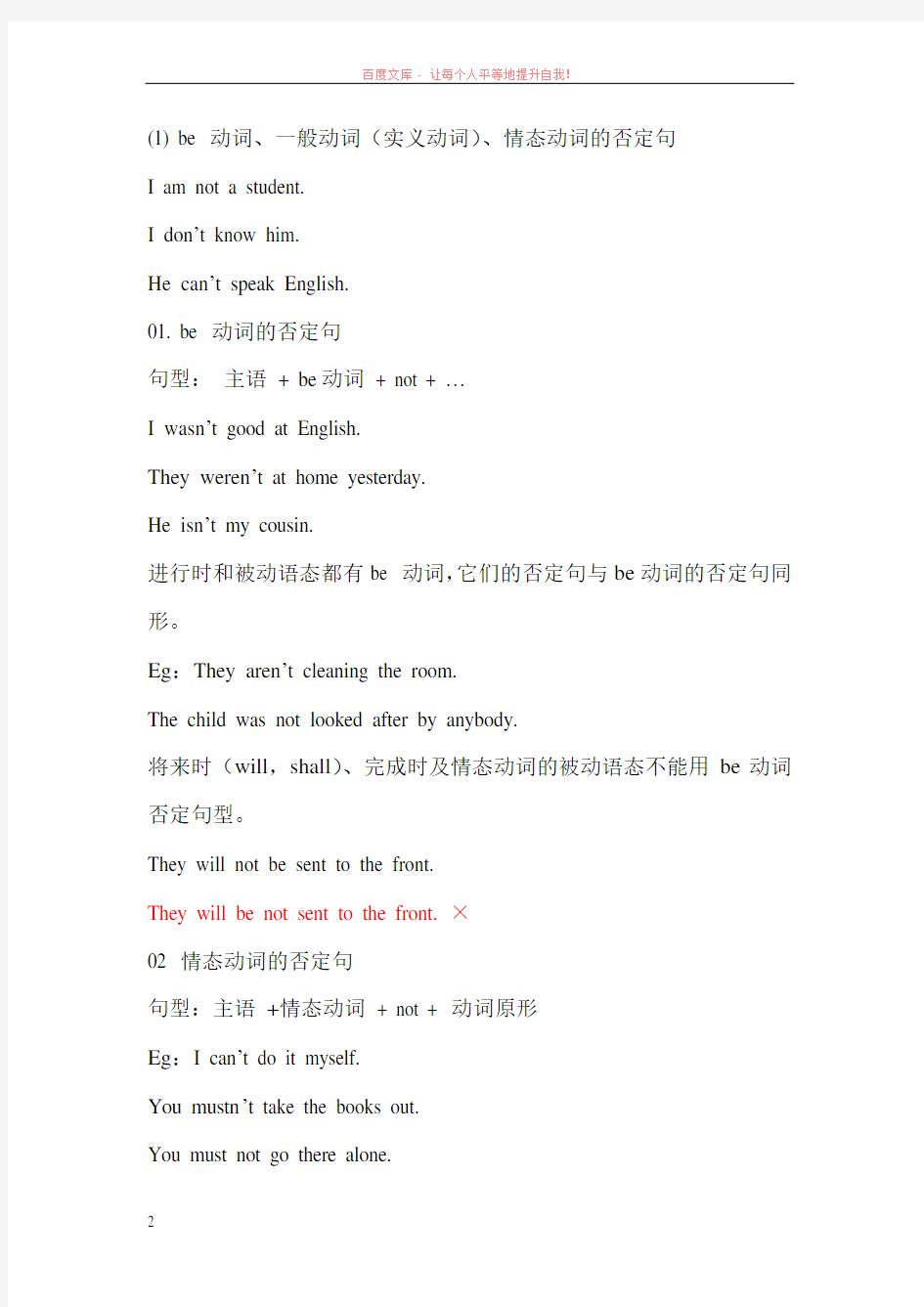

初中英语语法之句子的种类
英语中的句子按其使用目的,句子可分为:陈述句、疑问句、祈使句、和感叹句。
按语法结构,句子可分为简单句、并列句和复合句。
Eg:
陈述句:This is a dog.
疑问句:Is this a dog?
祈使句:Open your eyes!
感叹句:What a beautiful building it is!
简单句:I am studying.
并列句:I was born in a small village and I lived there for nearly ten years.
复合句:As soon as I get there, I’ll call you.
1 陈述句
凡是说明一件事情,提出一个看法,或者是表达一种心情的句子都是陈述句。大多数的句子都是陈述句,陈述句可以用肯定式和否定式。陈述句句末用句号“.”,通常用降调。
Eg:We live in Beijing.
We don’t live in Beijing.
(1) be 动词、一般动词(实义动词)、情态动词的否定句
I am not a student.
I don’t know him.
He can’t speak English.
01. be 动词的否定句
句型:主语+ be动词+ not + …
I wasn’t good at English.
They weren’t at home yesterday.
He isn’t my cousin.
进行时和被动语态都有be 动词,它们的否定句与be动词的否定句同形。
Eg:They aren’t cleaning the room.
The child was not looked after by anybody.
将来时(will,shall)、完成时及情态动词的被动语态不能用be动词否定句型。
They will not be sent to the front.
They will be not sent to the front.×
02 情态动词的否定句
句型:主语+情态动词+ not + 动词原形
Eg:I can’t do it myself.
You mustn’t take the books out.
You must not go there alone.
03 一般动词的否定句
句型:主语+ do/does/did + not + 动词原形
Eg:
They didn’t live in Shanghai.
He doesn’t do his homework every day.
They didn’t have the class-meeting yesterday afternoon.
04现在完成时的否定句
句型:主语+ have/has+ not + 动词的过去分词+……
I haven’t finished reading the book yet.
He hasn’t had his breakfast yet.
05过去完成时的否定句
句型:主语+ had+ not + 动词的过去分词+……
He had n’t finished reading the book by the end of last month.
(2).否定结构应注意事项
01 使用not 的部分否定
含有not的句子,如果使用了very, always以及不定代词all, both, every 及every的复合词,则表示部分否定。
Eg:
I don’t play football very well.
It isn’t always hot here in summer.
02 not的其他否定表示
1. not… at all 一点也不…
I’m not tired at all.
I don’t like it at all.
2. not…any more, not… any longer 再也不…
I don’t live here any longer. = I no long live here.
I can not eat any more. = I can eat no more.
03 使用not 以外的否定词表示否定
1.用no表示:no+名词= not any…一点也不…There is no wind. = There is not any wind.
2. never 绝不
I will never forget you.
He has never been abroad.
3. few / little 几乎没有
He has few friends.
Few people understand the difference.
I have little money.
There is little water in the glass.
4. no one = nobody 无人
No one knows the answer.= Nobody knows the answer.
5.nothing = not anything 什么也没有
I have nothing to do today.
6. none of …没有任何人;什么也没有
None of them can answer it.
I eat none of the food.
7.含有否定副词seldom /hardly的句子
He can hardly write his name.
We seldom watch TV.
04 too…to…(太…以至于不….) 的句型表示否定
He is too old to work.
不定代词的肯定和否定形式
肯定否定肯定否定
all none, no some not any, no everyone, each no one something not anything, nothing everything nothing a few few
Each, both, either neither, not either a little little
2 祈使句
表示请求、命令。建议等。句子没有时态变化,谓语动词一律用原形。句子中通常不用主语,句末用感叹号或者句号,用降调。
1.含有第二人称主语的祈使句
Be careful!
Don’t make such a noise.
01 肯定的祈使
句型动词原形+ …+(省略主语)
Stand up.
Be quiet, please.
1.有时,为了加强语气,可以在动词之前加do.
Do sit down.
Do study hard.
2.用客气的语气表示祈使句时,可在句首或句尾加上please,但如果
在句尾加please时,那在please之前一定要加一个逗号“,”。Go this way, please.
3.祈使句中如果有唤语,一定要用逗号“,”隔开,放在句首或句尾。Li Ming, come here.
Come here, Li Ming.
02 否定的祈使句
句型Don’t +动词原形+…
Don’t swim in the river.
Don’t be late.
Please don’t be noisy.
句型转换之祈使句和陈述句的改写
祈使句= You must…
Come here. = You must come here.
Don’t do that again. = You mustn’t do that again.
Please + 祈使句= Will you (please)…?
Please help me. = Will you (please) me ?
2 含有第一、第三人称主语的祈使句
Let’s say goodbye here.
Don’t let him do that again.
01 肯定的祈使句
句型let+第一人称(me, us)+动词原形+…
let+第三人称代词(him/her/it/them)或名词+动词原形+…
let me try again.
Let’s go at once.
Let Tom go there himself.
02 否定的祈使句
Let’s + not + 动词原形+…
Don’t let + 第三人称代词的宾格或名词+动词原形+…
Let’s not say anything about it.
Don’t let them play with fire.
句型转换
Use your head and you will find a way.
If you use your head, you will find a way.
3 感叹句
表示喜怒哀乐等强烈感情时用感叹句。感叹句分为两种:一种以what 引导,一种以how引导。句尾用感叹号,通常用降调。
What a clever boy he is.
How clever the boy is.
1 what 引导的感叹句
句型what + 名词(或形容词+名词)+陈述句(主语+谓语)
What a beautiful city it is!
What a fine day!
What an honest man he is!
What big apples these are!
What a tall boy Tom is!
What fools they are!
2 how 引导的感叹句
句型How+形容词或副词+陈述句(主语+谓语)!
How hot it is today!
How high the kite is flying!
How beautiful the girl is!
How fast he runs!
How I want to be a teacher!
How well she can skate!
感叹句:How busy you are!
疑问句:How busy are you?
3 if only 引导的感叹句
用if only 引导的感叹句通常表示一种强烈的愿望,特别是表示对一
些不能实现的或没有实现的愿望的遗憾感。
句型if only +主语+ 一般过去时/were
If only I knew her telephone number!
If only he were here!
句型if only +主语+ could / would + have +过去分词
If only we could have gone to the party!
4 其他形式的感叹句
感叹句除用what和how引导外,还有许多其他形式,如可用陈述句,疑问句,祈使句等,有时甚至一个单词或一个短语也可构成感叹句。The garden looks so lovely today!
Isn’t it a lovely day!
Fire!
Very good!
陈述句用作感叹句时,句中通常有so, such, really等加强语气的词语,疑问句用作感叹句时,句子多为否定疑问句。